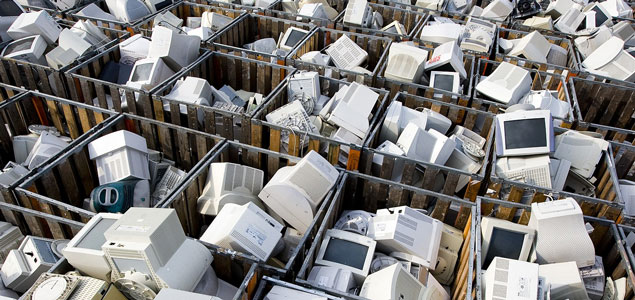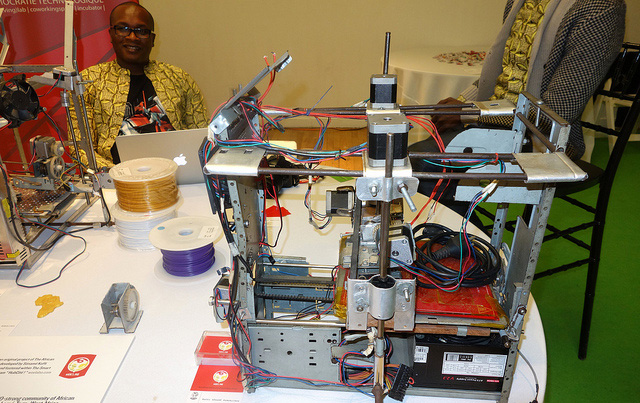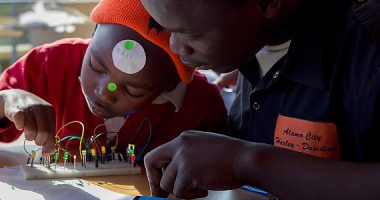
E- Recycling. Source: Wikipedia.
The perverse circle of technology closes when the countries of the North dispose of their electronic waste. They sweep it under the carpet in invisibilised places in the South, such as Africa for example – the very same continent from which some of the raw materials required to produce the technology were extracted from in the first place. E-waste traffickers are not concerned about the impact of this waste, they simply take it far away, out of sight. But in the midst of this almost apocalyptic scenario, Africans themselves are endeavouring to turn the tables, to make the best of whatever small positive effect can come out of this technological aberration. They do so by drawing on some almost anthropological strategies such as the connection with the environment, and immunisation (at least for the time being) against frenzied technological consumption.
In mid-October, Ghanaian architect DK Osseo-Asare showed some photos in which it was possible to make out the shapes of some young people in the midst of dense black smoke, surrounded by rubbish. “All that matters is the fact that these young people are condemned to get sick and die,” he explained during a visit to Barcelona. Along with Yasmine Abbas, DK Osseo-Asare is co-organiser of the Agbogbloshie Makerspace Platform (AMP), a collaborative initiative based in the e-waste dump at Agbogbloshie near the Ghanaian capital Accra, which is considered to have the world’s worst pollution problems.
DK explains that the unorganised workers at the dump earn their own and their families’ livelihoods there. This makes it unlikely that they will stop working even if they put their lives at risk by burning the plastic covering the components they harvest, for example, and thus exposing themselves to all types of deadly pollutants. For this reason, AMP focuses on finding ways to allow them to continue to work, but to do so safely. At the same time, the initiative aims to find ways to breathe new life into these discarded materials. AMP is one of the best examples of “upcycling”, a trend that goes beyond reusing discarded materials, and instead finds a use that adds value. In other words, it is a process in which recycling does not entail a gradual loss of value, but actually increases value.
Not far from Ghana, in Lomé, the capital of neighbouring Togo, Koffi Sénamé Agbodjinou is the soul of WoeLab, an atypical fablab that aspires to light the spark for a revolution combining urbanism, technological innovation, and social change. Sénamé is convinced that technology can change the way cities are built, and at the same time transform the social relations that take place in them. But aside from complicated theories, WoeLab is the space and the ecosystem that made it possible to create the African-made 3-D printer from e-waste, called the W.Afate. This invention is the ultimate expression of what Agbodjinou calls “LowHighTech”, or modest cutting edge technology.
This idea of technological innovation that Agbodjinou defends is not just modest because it uses waste materials and discarded components, but because it is within everybody’s reach. Everybody can access it and, moreover, anybody can build it. The founder of WoeLab believes that the transformative power of technology must be available to everybody, if it is to exist at all: above all, genuinely African aspiration. “We don’t see recycling as an intrusion, because recycling is always on our minds; we try to fix or reuse everything before throwing it away,” Agbodjinou says. Their high tech is popular, accessible, practical and democratising, in contrast to the West’s elitist, discriminatory idea of high tech that leads to the widening of the digital divide.
Emeka Okafor is one of the best-known figures of the maker movement in Africa, which draws heavily on craftsmanship as a fundamental aspect of the creation of technology. Over time, he has become the mentor of many of the projects that are springing up along these lines. The clearest example of his work is the promotion of the Maker Faire Africa, which will celebrate its fifth edition in Johannesburg in December this year. Okafor expresses the same view as the others mentioned above when he says that, technologically speaking, the maker movement “is not a new phenomenon in Africa, it has always existed.” This promoter of innovation is referring to the tendency of the inhabitants of Africa to make their own inventions, reproducing devices that they are unable to acquire because of the whims of the market.
Okafor argues that in an environment like Africa where raw materials are scarce, recycling is one possible solution, and a highly accessible one. This explains why the continent in giving rise to projects that serve as a model for the countries of the North, and reveals the creative potential of people who are used to finding their own solutions to problems.
Upcycling, modest high tech, and the craft of technological innovation are similar, what we could call “sister” dynamics. They share the same desire – to find solutions to more or less commonplace problems; the same strategy – creativity that goes beyond formal technical knowledge; the same materials – reused discarded resources; and, above all, the same objective – to bring about social change.
As the hacker current and the maker movement are closely tied to the technological society, our imaginaries tend to think of them as Western, from the North, from so-called developed countries, even if they are actually dynamics with a critical DNA. The assumption is unconsciously and unintentionally another of the fruits of our Euro-centrism. Koffi Sénamé Agbodjinou makes a revealing observation: “In hacker communities I found many similarities with the tamberma constructors of north Togo. They use local materials that they have at hand, they take advantage of the know-how of the community, they seek to share knowledge, they bring together specialists from different fields, and they feel they have a duty to give back to the community.”
The achievements of hacker groups around the world are beyond question, even though it is difficult for them to get access to the most highly specialised circles. The ever-increasing numbers of people who form part of them are managing to secure their place in international conventions, conferences and fairs related to technological innovation. They sometimes still seem like rather exotic individuals, although they can also personify a sincere appreciation. In any case, their contributions arouse considerable interest and, often, admiration. These positive outcomes (both the appreciation and the materialisations, that is, the devices they create) are promoting the proliferation of specific spaces for their work. Events linked to the maker movement and fablabs are springing up all over Africa, just as tech labs did in earlier years, and often hand in hand with, or sheltered by, these older siblings.
There is hardly a digital community worth its salt left in Africa without its own makerspace, or at least a programme of workshops or small technological maker fairs.

The W.Afate, the first 3D printer “made in Africa” using waste material, in WoeLab, Togo. Author: Nick Normal.
Over a decade ago (an eternity in technological terms) there was already some buzz about the “inventions” that African citizens came up with so that they could use mobile phones, for example, in rural environments where they had no access to electricity. Although not much time has gone by since then, it seems as if eons had passed because technology has gone through so many changes. Technological innovation requires imagination, creativity, and the will to overcome obstacles. But above all, it requires the ability to put the popular saying of “making a virtue of necessity” into practice. History has shown that all of these are plentiful in Africa, and that the only element of the equation that is missing or scarce is material resources. But this is not an insurmountable obstacle either: recycling has become the way of accessing the necessary materials.
In Africa, the spirit of innovation has arrived before the more entrepreneurial drive. The continent was the source of many of the raw materials that allowed the tech industry to grow, but the big corporations did not consider Africa an attractive place to set up a manufacturing industry in this sector. Due to its marginal nature (in the etymological sense of “being on the margins”), the maker movement and all the dynamics that go with it has managed to find its way through the cracks that the emerging digital ecosystems have opened up in the continent’s isolation. As well as its desire to build and create, the maker movement (as its manifesto declares) relies on the foundation of community and collaborative work. Given this, it would certainly be impossible to find a more appropriate and better predisposed breeding ground for makerspaces than African societies.
Beyond individual capabilities, the communities that have embraced the maker movement, the spirit of open source, the hacker philosophy, and the practice of recycling are coming together to form an increasingly dense web. They are strongly interconnected (we need look no further than the tree examples given here, which collaborate and, curiously, mention each other); they “infect” other communities with which they share an interest in technologies and the desire for social change; and they are having a profound impact on young people. All of these mixes of relations, examples, models, collaborations, proposals, and materialisations form a complex network that releases creative energy, and it is difficult to gauge what its limits may be. For the time being, we can safely affirm that they are capable of generating hope in the most contaminated place on earth, and of constructing a 3D printer using electronic waste.






Leave a comment